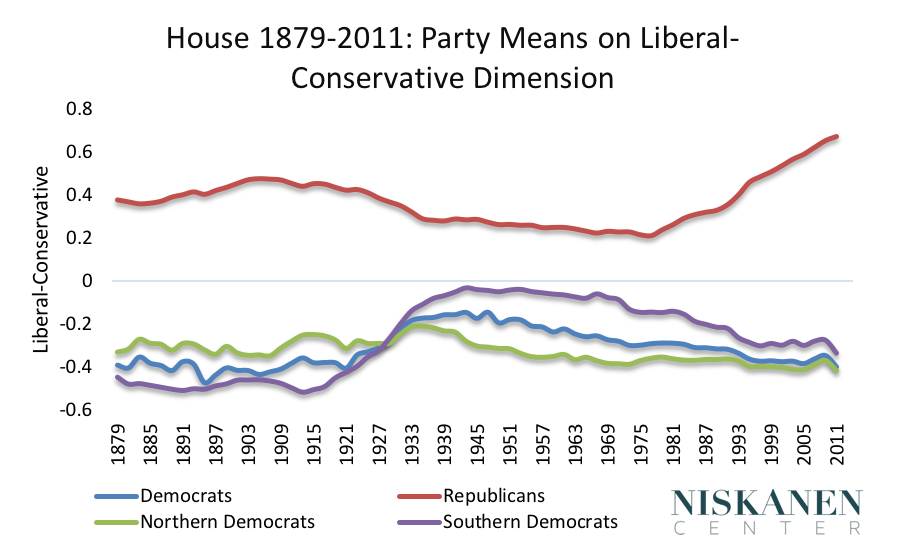The American political system is broken. The fact that we have problems in our society is not new. Our seeming inability to fix, or even address, them is a distinctive feature of our age, however. We know what these problems are. They include, among others, an economy that, even when it is working, distributes rewards in an increasingly unequal manner; an educational system that fails to educate a significant portion of our population; an infrastructure in disrepair; widespread racial and cultural conflict; declining national power and prestige; and an environmental crisis that threatens human life on our planet.
The scale of these challenges is daunting, but far from unprecedented — and in fact, smaller than previous ones we have faced. In the past century we experienced the Great Depression, World War II, the threat of nuclear annihilation, and a devastating war accompanied by severe domestic turmoil. Yet regardless of the difficulties we faced, there was a sense among the public that our problems were solvable, and our political system performed in a way that justified this optimism. Today our politics are increasingly polarized, and our elected officials seem to be continually deadlocked. Meanwhile, our problems continue, nothing gets done, and there is little faith among the public that our elected officials can work together to find solutions.
Several explanations have been proposed to account for our polarization. Some observers have suggested that today’s Americans tend to self-select into communities with like-minded people, which reduces our exposure to alternative perspectives. Others have argued that the proliferation of new technology has made it easier to tailor our newsfeeds exclusively to material that supports our existing positions. These accounts, accurate as they may be, fail to separate cause from consequence. The fact that we prefer like-minded people, and information that reinforces rather than challenges our views, is as likely the result of our polarization as the cause of it.
Any effort to account for our current predicament must recognize that polarization is typically accompanied by extremism. Politics by definition involves disagreement, and in a well-functioning system, those who disagree will hash out their differences and reach an accommodation. When the opponents are far apart, this agreement is difficult, and often impossible, to achieve. To explain our polarization, then, we will have to account for the sources of extremism. That is my goal in this essay.
Before approaching this question, we must clear up an important misconception: There is a widespread belief that both the Republican and Democratic parties have become more extreme in recent years. “Both sides are to blame,” we repeatedly hear. It is certainly true that neither of our two major parties is perfect, nor is either immune from responsibility for our current stalemate. To assume that they are equally extreme and intransigent is not true, however. The graph below, compiled by Professor Keith T. Poole at the University of Georgia, shows the average political positions on a conservatism-liberalism scale of Democratic and Republican members of the House of Representatives since 1879.[1]

Although Southern Democrats have become more liberal in recent decades (due to the disappearance of conservative white Southerners from the party), the degree of liberalism among non-Southern Democrats has remained virtually stable since the early 1960s. Republicans, on the other hand, began to move in an increasingly conservative direction in the late 1970s and have become sharply more conservative since that time. As the graph shows, the widening ideological gap between the two parties since 1980 can be accounted for almost entirely by the increasing conservatism of the Republicans.
The question is, what accounts for this increasing extremism of the Republican Party, and the polarization that has resulted from it? I argue that it stems from what many may view as an unlikely source: a decline in leadership by large American corporations, a group I refer to as the American corporate elite. There was a period, from the end of World War II into the 1970s, when the leaders of American big business were a source of moderation and pragmatism who exhibited a degree of concern for the larger population. Today’s corporate elite — despite the many individuals and firms who have engaged in socially responsible activities — is a disorganized, atomized group, incapable not only of addressing larger societal needs but even its own collective interests. In the post-World War II period, from 1945 to the mid-1970s, the heads of large corporations not only contributed to the phenomenal economic success that we experienced, but they also played a major role in helping our political system work. They did this in part by keeping at bay, and delegitimizing, the extremist elements that were as present in our society then as they are now.
[1]This graph is reproduced here with Professor Poole’s permission. The measures of conservatism and liberalism are based on the “DW-Nominate” procedure developed by Poole and Howard Rosenthal. Information about and references to the measure can be found at https://voteview.com/about. For a graph that updates the current data through 2018 (and shows virtually identical results using a slightly different method), see https://voteview.com/articles/party_polarization. I thank Professor Poole and Professor Jeffrey B. Lewis (at the University of California, Los Angeles) for directing me to these data.
Photo Credit: US Department of Labor / Public domain